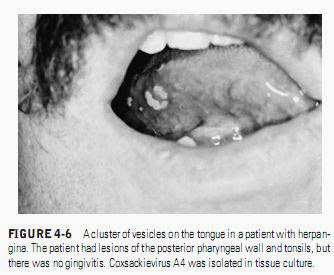Coxsackievirus A4 has been shown to cause a majority of cases of herpangina, but types A1 to A10 as well as types A16 to A22 have also been implicated. Because many antigenic strains of coxsackievirus exist, herpangina may be seen more than once in the same patient. Unlike herpes simplex infections, which occur at a constant rate, herpangina frequently occurs in epidemics that have their highest incidence from June to October. The majority of cases affect young children ages 3 through 10, but infection of adolescents and adults is not uncommon.
Clinical Manifestations. After a 2- to 10-day incubation period, the infection begins with generalized symptoms of fever, chills, and anorexia. The fever and other symptoms are generally milder than those experienced with primary HSV infection. The patient complains of sore throat, dysphagia, and occasionally sore mouth. Lesions start as punctate macules, which quickly evolve into papules and vesicles involving the posterior pharynx, tonsils, faucial pillars, and soft palate. Lesions are found less frequently on the buccal mucosa, tongue, and hard palate (Figure 4-6). Within 24 to 48 hours, the vesicles rupture, forming small 1 to 2 mm ulcers. The disease is usually mild and heals without treatment in 1 week.
Herpangina may be clinically distinguished from primary HSV infection by several criteria:
1. Herpangina occurs in epidemics; HSV infections do not.
2. Herpangina tends to be milder than HSV infection. 3. Lesions of herpangina occur on the pharynx and posterior portions of the oral mucosa, whereas HSV primarily affects the anterior portion of the mouth.
4. Herpangina does not cause a generalized acute gingivitis like that associated with primary HSV infection.
5. Lesions of herpangina tend to be smaller than those of HSV.
Laboratory Studies. A smear taken from the base of a fresh vesicle and stained with Giemsa will not show ballooning degeneration or multinucleated giant cells. This helps to distinguish herpangina from herpes simplex and herpes zoster, which do show these changes.
Treatment. Herpangina is a self-limiting disease, and treatment is supportive, including proper hydration and topical anesthesia when eating or swallowing is difficult. Specific antiviral therapy is not available.
Treatment. Herpangina is a self-limiting disease, and treatment is supportive, including proper hydration and topical anesthesia when eating or swallowing is difficult. Specific antiviral therapy is not available.
